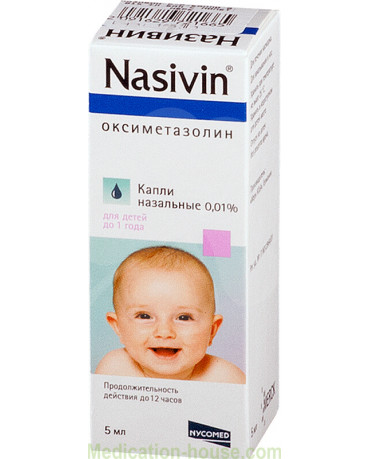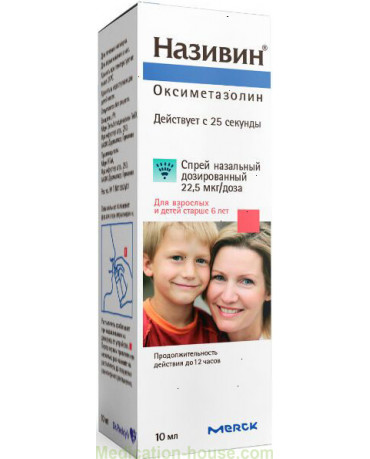Instruction for Nasivin Sensitive
To buy Nasivin Sensitive just add it to your shopping cart
pharmachologic effect
Nasivin Sensitive stimulates alpha adrenergic receptors, which cause intense vasoconstriction. With intranasal administration, this action promotes drainage and improves ventilation. Ophthalmic administration causes a narrowing of the vessels of the conjunctival blood vessels, thereby providing relief from minor eye irritations. In patients with rosacea, topical application may reduce facial erythema. Oxymetazoline is administered by the local, ophthalmic and intranasal routes. After systemic absorption, the drug is approximately 57% bound to human plasma proteins. In vitro studies using human liver microsomes showed that oxymetazoline underwent minimal metabolism, with 96% of the original drug remaining intact after a 120-minute incubation. Excretion and final half-life have not been determined. Affected cytochrome P450 isoenzymes and drug carriers: none. A pharmacokinetic study evaluating the use of oxymetazoline cream in adults with rosacea revealed measurable plasma concentrations of the drug in most patients. After the first application, the average peak concentrations (Cmax) and exposure (AUC) were 60.5 +/- 53.9 pg / ml and 895 +/- 798 pg x hour / ml, respectively. After a single daily application for 28 days, the average values of Cmax and AUC were 66.4 ± 67.1 pg / ml and 1050 ± 992 pg × hour / ml, respectively; thus, indicates a small accumulation of drugs.
Indications
An alpha adrenoreceptor agonist acting as a vasoconstrictor is available as an intranasal spray and ophthalmic solution. It is indicated for the treatment of nasal congestion (intranasal spray), redness of the eyes due to minor eye irritants (ophthalmic solution). It is also often used in medical courses for: • acute respiratory infections with subsequent inflammation in the oropharynx; • an allergic reaction to allergens inhaled with air; • an exacerbated form of the common cold, in which the tone of the vessels of the nasal mucosa is disturbed; • inflammation of the mucous membrane of one or more sinuses; • an inflammatory process localized in the Eustachian tube and of acute or chronic nature; • inflammatory disease of the middle ear associated with infection.
Contraindications
Nasivin Sensitive has several contraindications: • individual intolerance to any component of the drug; • chronic inflammatory lesion of the nasal mucosa, characterized by atrophy of the mucous membrane; • a rare form of glaucoma, which mainly occurs with hyperopia in people over the age of 30.
Dosage and administration
An ophthalmic dosage is used to relieve itching and redness of the eyes due to slight eye irritation. For adults, adolescents and children 6 years of age and older: if necessary, instill 1-2 drops in the affected eyes every 6 hours. Do not exceed recommended dose. Overuse can lead to increased redness of the eyes. A nasal spray is used for temporary symptomatic relief of nasal congestion due to a runny nose, hay fever, and upper respiratory allergy. For adults, adolescents and children 6 years of age and older: if necessary, use 2 or 3 spray injections into each nostril every 10-12 hours. Do not exceed 2 doses in 24 hours. The duration of treatment should not exceed 3 days. Prolonged use may lead to relapse or worsening of nasal congestion in the child. For children under 1 year old, use 1 drop in each nasal passage.
Pregnancy and lactation
Data is limited regarding the use of oxymetazoline during pregnancy. No adequate and well-controlled trials have been conducted, and it is not known whether the drug causes fetal damage or adverse pregnancy outcomes. Data from one published article revealed a potential relationship between exposure to oxymetazoline nasal spray in the second trimester and abnormalities of the renal collection system. In another case, fetal distress was recorded in a 41-week-old pregnant woman after repeated use of the oxymetazoline nasal spray at a dose 5 times the recommended dose. An intrauterine disorder went away a few hours before birth in a healthy baby. Exposure to oxymetazoline topical cream has also been reported in two pregnant women. One pregnancy led to the birth of a healthy baby. Another pregnancy ended in a spontaneous abortion, which was not considered to be related to the effect of the drug. It is not known whether oxymetazoline is distributed into breast milk or if the drug affects the production of breast milk. According to the manufacturer, caution should be exercised when administered to women who are breastfeeding their children. Think about the benefits of breastfeeding, the risk of potential drug exposure in babies, and the risk of no treatment or inappropriate treatment. If breastfeeding experiences an adverse effect related to ingestion, doctors are advised to report adverse effects to the FDA.
Side effects
Nasivin Sensitive may cause: • migraines; • violation of the sleep cycle; • mucosal atrophy; • tachycardia; • hyperemia.
Overdose
In case of an overdose, the reaction to Nasivin Sensitive may worsen. It is recommended to consult a doctor and stop using the drug.
Drug interaction
It is not recommended to use Nasivin Sensitive simultaneously with anesthetics.
special instructions
Use the nasal form to treat the nose. Do not use to treat eyes. Do not use Nasivin Sensitive at the same time as analogues.
Terms and conditions of storage
Do not expose the drug to high temperatures. Nasivin Sensitive in Moscow is available without a prescription.
Terms of sell
You can buy Nasivin Sensitive without a prescription from a doctor.



